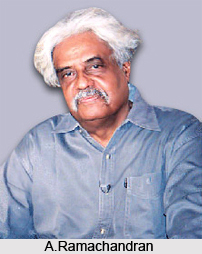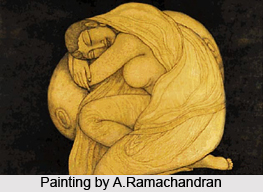 A.Ramachandran was born in 1935 in Kerala. He graduated with a degree in Malayalam Literature from Kerala University before pursuing a Diploma in Fine Arts and Crafts from Kala Bhavan, Visva Bharati University at Shantiniketan. He has been deeply influenced by Nandalal Bose. He makes a strong case for Indian aesthetics and for the use of classical Indian images. The painter converted to use of archetypal Indian imagery after years of painting in the modernist element. He has been influenced by the prevalent socio-political situation in Kerala. His early works represented oppression, violence and war. Human figures were dissected, most of them headless.
A.Ramachandran was born in 1935 in Kerala. He graduated with a degree in Malayalam Literature from Kerala University before pursuing a Diploma in Fine Arts and Crafts from Kala Bhavan, Visva Bharati University at Shantiniketan. He has been deeply influenced by Nandalal Bose. He makes a strong case for Indian aesthetics and for the use of classical Indian images. The painter converted to use of archetypal Indian imagery after years of painting in the modernist element. He has been influenced by the prevalent socio-political situation in Kerala. His early works represented oppression, violence and war. Human figures were dissected, most of them headless.
Initially he painted in an expressionist style which reflected the urban life most expressively. However by the `80s his work underwent a sea-change. One would find that several aspects of Indian classical art have been integrated into his art, including compound motifs and imagery and decorative elements. He has extensively used Kerala murals, Nathadwara paintings and Ajanta murals in his works. However, in most of his works the decorative element are not visible, it is intrinsic. Ramachandran believes that his monumental painting `Yayati` was one of the landmarks in his growth as an artist as it allowed him to incorporate elements of classical proportions and postures in his work. Myths became a great store for him.
 He considered Ramkinker as his guru and created sculptures which were more intriguing in formal terms than his paintings. Ramachandran has had several solo shows, some of which include `Recent Works` at Grosvenor Vadehra, London, in 2008; `Face to Face: Art Practice of A Ramachandran` at the Guild Art Gallery, Mumbai and New York, in 2007-08; and `Illustrations of Gaudi`s Ocean` at Nami Island, South Korea, in 2005. Three retrospective exhibitions of his work have been organized by Vadehra Art Gallery in 2004; by the National Gallery of Modern Art (NGMA), New Delhi, in 2003; and by Kumar Gallery at Art Heritage, New Delhi, and Jehangir Art Gallery, Mumbai, in 1983. Ramachandran has also participated in several group shows including `Progressive to Altermodern` at Grosvenor Gallery, London, in 2009; `From Everyday To The Imagined: Modern Indian Art` at the Singapore Art Museum, Singapore, and the Museum of Art, Seoul, in 2007-08; the `Festival of India` at Coups de Coeur, Geneva, in 1987; the Sao Paulo Biennale, Brazil, in 1979; the Menton Biennale, France, in 1974; and the New Delhi Triennale, India, in 1968.
He considered Ramkinker as his guru and created sculptures which were more intriguing in formal terms than his paintings. Ramachandran has had several solo shows, some of which include `Recent Works` at Grosvenor Vadehra, London, in 2008; `Face to Face: Art Practice of A Ramachandran` at the Guild Art Gallery, Mumbai and New York, in 2007-08; and `Illustrations of Gaudi`s Ocean` at Nami Island, South Korea, in 2005. Three retrospective exhibitions of his work have been organized by Vadehra Art Gallery in 2004; by the National Gallery of Modern Art (NGMA), New Delhi, in 2003; and by Kumar Gallery at Art Heritage, New Delhi, and Jehangir Art Gallery, Mumbai, in 1983. Ramachandran has also participated in several group shows including `Progressive to Altermodern` at Grosvenor Gallery, London, in 2009; `From Everyday To The Imagined: Modern Indian Art` at the Singapore Art Museum, Singapore, and the Museum of Art, Seoul, in 2007-08; the `Festival of India` at Coups de Coeur, Geneva, in 1987; the Sao Paulo Biennale, Brazil, in 1979; the Menton Biennale, France, in 1974; and the New Delhi Triennale, India, in 1968.
As acknowledgement to such a talent, A. Ramachandran has been conferred honours like- Padma Bhushan in 2005, Government of India; Raja Ravi Verma Puraskar in 2003, Government of Kerala; Manaviyam Award in 2001, Manaviyam Cultural Mission, Government of Kerala; Gagan-Abani Puraskar in 2000, Viswa Bharati University; Parishad Sanman in 1991, Sahitya Kala Parishad, New Delhi; Noma Award for Children`s Picture Book Illustration in 1980; Noma Award for Children`s Picture Book Illustration from Japan in 1978; National Award for Painting, in the years 1973 & 69, New Delhi.



















